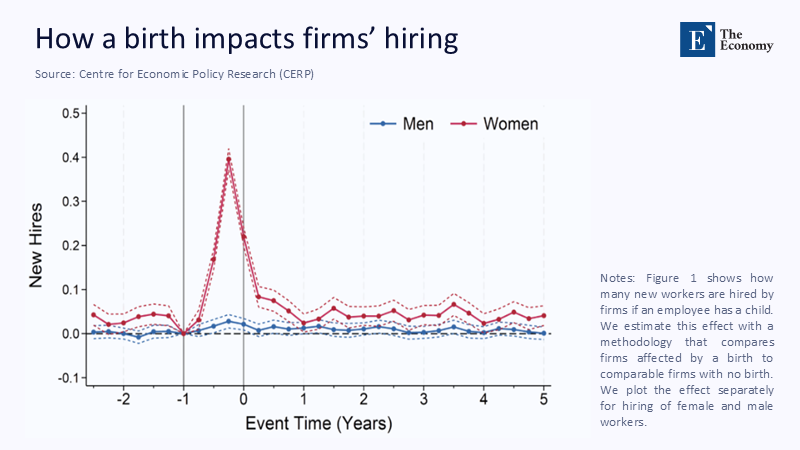Parental Leave Predictability Is the Missing Link in Solving Teacher Shortages
Input
Modified
This article is based on ideas originally published by VoxEU – Centre for Economic Policy Research (CEPR) and has been independently rewritten and extended by The Economy editorial team. While inspired by the original analysis, the content presented here reflects a broader interpretation and additional commentary. The views expressed do not necessarily represent those of VoxEU or CEPR.
Every school day, dawn begins with an anxious shuffle: roughly one in ten American teachers fails to appear in front of their class. Run that quiet ratio through a spreadsheet, and it shouts—3.2 million full-time educators, substitutes paid between USD 100 and USD 250 a day, and an 8% daily vacancy now siphons about USD 25.6 million from public school budgets every single day, more than USD 4.4 billion over a standard 175-day academic year. Those billions buy stop-gap coverage, not continuity. They purchase strangers hastily briefed on yesterday’s lesson plans, fragmented project timelines, and a steady erosion of community trust. The scale of the problem exposes a policy blind spot: We talk about how generous or stingy parental leave should be, yet we rarely confront how unpredictability amplifies its real cost within an already strained education workforce. In 2025—with teacher shortages widening and budget ceilings hardening—predictability is no longer a courtesy; it is the fulcrum on which instructional quality, fiscal sanity, and educator retention now pivot.

Beyond Calendars: Redefining Predictability as Ecosystem Design
Predictability is often framed as nothing more than early notice, a courtesy email that lets colleagues mark a future absence in red on the staff calendar. But schools are not cubicle farms with interchangeable workloads; they are interdependent ecosystems where lesson sequencing, child-care schedules, bus routes, and community partnerships mesh like gears. The OECD’s Education Policy Outlook 2024 found that the proportion of lower-secondary students taught in schools reporting teacher shortages surged from 29% in 2015 to 46.7% in 2022. Shortages create brittle networks in which even a single unplanned parental leave extension can trigger weeks-long cascades: electives canceled, special-education minutes unserved, enrichment tutors redeployed, and professional development budgets raided to fund last-minute coverage. Under such systemic tension, merely knowing when a teacher will be gone is insufficient; leaders must anticipate how tasks will reroute and how much cognitive load the rerouting itself will impose. Predictability thus becomes a deliberate act of organizational engineering that shields scarce learning time from ambient volatility.
That broader lens explains why forward-thinking districts are beginning to borrow from private-sector “fair workweek” rules, now spreading from New York to Los Angeles County. The new LA ordinance, effective July 2025, obliges large retailers to post schedules at least fourteen days in advance or pay a financial premium for last-minute changes. Although aimed at hourly retail staff, the logic resonates for schools: unpriced volatility is a hidden tax. Randomized trials in the service sector show that stable schedules can lift sales by 7% and labor productivity by 5%. Translate that return into educational currency, and the benefits multiply: smoother pacing guides, fewer lesson restarts, more sustained small-group interventions, and measurable gains in student trust. Most critically, predictability broadens the planning horizon from one substitute roster to an entire year’s staffing choreography, aligning projects, accreditation checkpoints, and community events around known gaps rather than reacting to surprise ones. What looks like an HR courtesy on paper becomes, in practice, an instructional insurance policy.
What the Latest Numbers Tell Us about Leave, Learning, and Labor
UNESCO’s 2024 Global Report on Teachers warns of a 44 million-teacher shortfall worldwide by 2030, including 15 million in Sub-Saharan Africa alone. Meanwhile, in wealthier systems, vacancies and attrition persist: nearly half of OECD principals now report shortages that “hinder instruction.” To translate those abstractions into local budget lines, I applied the 10% daily absence figure to a standard U.S. district employing 2,000 teachers, multiplied by the midpoint substitute rate of USD 175. I then annualized the results across 175 school days. The product—USD 6.1 million—is a conservative estimate because it excludes intangible losses such as instructional misalignment, parental confidence, and administrator overtime spent orchestrating coverage. Even in flat-budget districts, hidden volatility quietly consumes the equivalent of a small elementary school’s entire annual expenditure.
Compounding the shortage is asymmetric access to family-supportive benefits. The RAND–NEA State of the American Teacher 2024 survey reports that only one-third of U.S. teachers have paid parental leave, compared with nearly half of similar working adults; among those with access, fewer than half deem the benefit adequate. Because unpaid leave often spawns unpredictable start-stop patterns—partial semesters, sick-bank donations—the coverage problem bleeds into instructional design: unit plans fragment, co-teaching stalls, and behavior incidents rise when classroom norms reset twice in the same term.

Layer on the 10% daily absenteeism rate, and a clear through-line emerges: benefits that fail to stabilize caregiving timelines inevitably destabilize learning timelines. This underscores the crucial need for equitable access to leave, ensuring that all teachers, regardless of their socioeconomic status, can provide stable and continuous education to their students.
Quantifying Predictability: Methods and Limitations
Several readers will want to peer under the hood of the dollar figures threaded through this column so that I can state the arithmetic plainly. To price unscheduled leave, I used the modal U.S. daily substitute range of USD 100–250 documented in 2024 coverage and adopted the midpoint value of USD 175 for all district-level models. I multiplied that rate by the 10% daily absence share and by 175 instructional days, adjusting for each payroll calendar. Where substitute pools were trimmed—as in Houston—I subtracted the reported 10% reduction from the previous roster, then annualized wages using the local hourly rate of USD 19.50. Productivity offsets draw on Saravanan Kesavan’s randomized Gap trial, which reported a 5% labor-productivity lift; I conservatively assume a 2% instructional-time gain in schools. Replacement costs reference RAND’s USD 20,000 per-teacher estimate, inflated to 2025 dollars using the Employment-Cost Index. None of these assumptions is sacred, but all are transparent, allowing policymakers to drop local inputs into the same spreadsheet and stress-test conclusions before legislating. The model remains deliberately conservative throughout.
The Hidden Curriculum of Task Reallocation
When predictability improves, the tasks that matter most stay with the professionals best prepared to handle them. A landmark multistore experiment at Gap Inc.—still the most rigorously evaluated scheduling intervention—showed that posting stable, advanced schedules led to a 7% jump in sales and a 5% rise in labor productivity, more than covering predictability payments. The causal mechanism was deceptively simple: managers no longer scrambled to fill last-minute gaps so they could align staff strengths with critical tasks. In schools, the parallel would be shielding AP labs, IEP meetings, and formative assessment windows from disruption, preserving both academic rigor and legal compliance. Predictability becomes a quiet curriculum-protection device that maintains the connective tissue between daily lessons and year-long mastery.
Houston ISD’s recent experience offers a real-time education analog. After tightening approval processes, forecasting substitute demand campus by campus, and embedding apprentices in high-absence departments, the district reduced its substitute pool by more than 10%. It decreased average teacher absences from nine to seven days, nearly halving the cohort with ten or more absences. On paper, Houston saved approximately USD 3 million in hourly wages; yet, principals report that the more valuable dividend is regained attention. Instead of triaging calls, they coached novice teachers, analyzed interim assessments, and launched project-based curricula that were too fragile for past volatility. Predictability is, therefore, an administrative time-release mechanism, reallocating managerial focus from firefighting to instructional leadership.
Policy Implications: Building Adaptive Capacity in Schools and Districts
Educators and site leaders control two levers. First, embed long-range absence forecasting into master scheduling at least two semesters ahead; second, redirect a portion of emergency-sub funds toward specialized “float” roles that shadow teach months before a leave. If a 2,000-teacher district cuts unscheduled absences by one day per teacher, it recovers USD 350,000—enough to finance eight floaters whose presence protects thousands more seat-hours. Those seat hours translate into quieter classrooms, smoother pacing, and measurable gains on formative assessments that rarely show up in headline budgets.
At the statehouse, legislators should treat predictability metrics as infrastructure. Small grants tied to semester-ahead staffing transparency, plus modest predictability pay for educators who lock leave twelve months out, create a virtuous loop: teachers internalize the value of early notice, districts budget strategically, and policymakers see where volatility remains concentrated. Evidence from retail shows predictability premiums rarely exceed 1% of payroll yet deliver multipliers of four to seven in productivity.

That is a bargain when the alternative is losing certified teachers—whose replacement costs average USD 20,000—and scrambling to onboard substitutes mid-semester. Closing the benefit gap so that at least two-thirds of educators have paid leave would dampen the pressure wave that unpredictable absences send through staffing grids.
Pre-Empting Objections: Cost, Complexity, and Equity
The loudest pushback is fiscal: why add predictability pay or fund co-teachers when budgets already strain? The Gap trial offers a data-driven rebuttal: stable scheduling delivered a 7% sales increase against a 1% labor cost—seven-to-one ROI. Education’s ROI manifests not in revenue but in learning growth. Regional Educational Laboratory data show that every ten teacher-absence days cuts student achievement by 3.3% of a standard deviation; trimming two days recoups two-thirds of that loss, far outstripping payroll spending on predictability incentives.
Equity concerns also surface: Will predictability standards privilege well-resourced schools? Current benefit data show the opposite. Because only one-third of teachers have paid parental leave—the lowest in high-poverty districts—maintaining the status quo entrenches inequity. UNESCO’s projection of 44 million missing teachers underscores that any policy restricting early-career educators’ ability to plan for family life accelerates the exodus, disproportionately harming the very communities already underserved. Implemented system-wide, predictability serves as both an equity tool and talent magnet, drawing diverse candidates who had ruled out teaching for fear of career-family incompatibility.
A Call to Architect Predictability
We opened with a billion-dollar hemorrhage measured in daily substitute invoices; we closed with a reminder that those costs are optional. Design parental leave as an ecosystem—not a scramble—and volatility becomes just another line in the budget that can be engineered down. The evidence is consistent: when absences are predictable months in advance and trigger embedded floaters, transparent task maps, and modest predictability pay, the system gains more than it spends. Learning time stabilizes, budgets bend toward prevention, and the profession broadcasts that care work and classroom work coexist. We have the data, the modeling tools, and the cross-sector precedents. What remains is the will to architect policies that treat predictability as essential infrastructure. Let the next legislative session—and the next budget cycle—turn that into design.
The original article was authored by Anne Ardila Brenøe, an Assistant Professor in the Department of Economics at the University of Zurich, along with two co-authors. The English version of the article, titled "How firms navigate parental leave: Evidence from Austria," was published by CEPR on VoxEU.
References
Farrell Pickett, A. M., & Attia, A. (2025, June 20). Fair Workweeks: Navigating the Patchwork of Predictive Scheduling Laws. GT Labor & Employment Blog.
Houston Chronicle. (2025, January 27). Houston ISD reduced substitute teacher count by over 10% amid dropping teacher absenteeism.
Kesavan, S., et al. (2023). Win–Win for Business and Workers: Evidence from a Predictable Scheduling Intervention at Gap Inc. WorkRise Network.
OECD. (2024). Education Policy Outlook 2024: Reshaping Teaching into a Thriving Profession from ABCs to AI. OECD Publishing.
RAND Corporation & National Education Association. (2024). State of the American Teacher Survey.
UNESCO. (2024, February 22). Global Report on Teachers: What You Need to Know.
Straight Arrow News. (2024, June 7). Teacher absenteeism has jumped since the pandemic, costing schools billions.





















